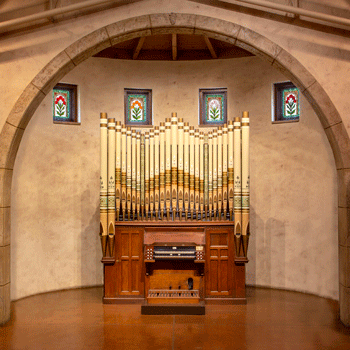
Schoenstein & Co., Benicia, California
Jacuzzi Family Vineyards, Sonoma, California
The sole remaining unaltered work of John Bergstrom & Sons, Opus 66, built in 1897 for the First Congregational Church of Sonoma, California, has been renovated and installed at the Jacuzzi Family Vineyards in Sonoma by Schoenstein & Co. When the music program of the church changed, Fred and Nancy Cline, owners of the winery, stepped forward to save the organ. Nancy Cline has a special interest in the preservation of California history. For example, the property includes an educational museum with models of all twenty-one California missions originally made for the 1939 World’s Fair. The extensive and opulent visitors’ center is designed in the style of an Italian villa. Its main feature is the Barrel Room, a space in Roman Basilica-style complete with apse and accommodating 250 guests, an ideal setting for banquets, weddings, or concerts.
The two-manual, eight-stop, mechanical-action, hand-pumped organ fits the apse of the Barrel Room as though built for it. Even the color scheme of the decorated pipes matches. The case sides were incomplete due to the original position of the instrument; thus visitors can view the interior of the organ, which has become a fascinating educational exhibit. Although a modern blower has been added, all else is original including its A = 435 pitch.
The metal pipework was of special interest. Cleaning revealed meticulously made and voiced pipes of the highest caliber. Obviously, they were made in the Bergstrom San Francisco shop as they were signed in the flat “John Bergstrom & Sons.” Comparing this instrument with the remnants of other Bergstroms in the area, it appears everything with possible exception of zinc pipes, keyboards, and small hardware was made in the shop as well.
The organ was dedicated in a June 2019 ceremony with recital by John Karl Hirten. Bergstrom Opus 66 has become an important cultural addition to the Northern California Wine Country.
Builder’s website: schoenstein.com
Vineyard website: jacuzziwines.com
GREAT (Manual I)
8′ Open Diapason 58 pipes
8′ Dulciana (12 fr Mel) 46 pipes
8′ Melodia 58 pipes
SWELL (Manual II, enclosed)
8′ Violin Diapason 58 pipes
8′ Salicional (12 fr St D) 46 pipes
8′ Stopped Diapason 58 pipes
4′ Flute Harmonic 58 pipes
Tremulant
PEDAL
16′ Bourdon 27 pipes
COUPLERS
Swell to Pedal
Great to Pedal
Swell to Great
Swell to Great Octave
Two combination pedals
8 ranks, 409 pipes

